Construction and function » Contrabass tuba » Philipp Dangas
Construction and function of the Contrabass tuba
Structurally, the contrabass tuba is basically the same as the bass tuba with the stipulation of larger dimensions corresponding to its deeper sound range. The contrabass tuba is built in two different pitches. As a contrabass tuba in C and slightly larger than this, as a contrabass tuba in Bb. Since it is used in art music down to the lowest range of the contra octave , it must always be equipped with 5 valves. As with the double horn and the tenor bass trombone, the bass tuba in F and the contrabass tuba in Bb can be combined in a single instrument by means of a switching valve. This tuba ensures good intonation in the lower register (the same applies to the higher register ) and is therefore used a lot.
Download size: 133 kilobytes
Table summary of the functional principle of the brass instruments
Table with key data on the functional principle of the brass instruments. Mouthpieces, tubes, bells and valves, will be briefly described. In addition, the term overblowing technique is defined.

The structure of a contrabass tuba in large representation
The lowest pitched tubas are the contrabass tubas, pitched in C or B♭, referred to as CC and BB♭ tubas respectively, based on a traditional distortion of a now-obsolete octave naming convention. The fundamental pitch of a CC tuba is 32 Hz, and for a BB♭ tuba, 29 Hz. The CC tuba is used as an orchestral and concert band instrument in the U.S., but BB♭ tubas are the contrabass tuba of choice in German, Austrian, and Russian orchestras.
In the United States, the BB♭ tuba is the most common in schools (largely due to the use of BB♭ sousaphones in high school marching bands) and for adult amateurs. Many professionals in the U.S. play CC tubas, with BB♭ also common, and many train in the use of all four pitches of tubas
Internal search function
| Name | Value | Delete |
|---|